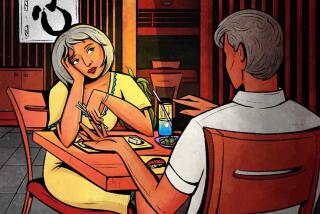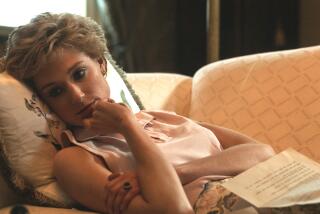A Private Life Lived in a Public Way
- Share via
Sixteen years ago on the eve of Lady Di’s marriage to the Prince of Wales, I was asked to do an essay about the impending wedding for the Style section of the Washington Post.
Haunted by the notion of this beautiful young girl consenting in a way to becoming a public prisoner for life, I wrote a very ominous piece. It began, “Don’t do it Di!” I argued that she would be giving up herself and her identity by marrying Prince Charles.
She was too young, I said at the time, to really know who she was to begin with.
The piece never ran.
My editors killed it. It was too negative, they said, and too pessimistic. Besides, this was a fairy tale. People wanted to believe in fairy tales and happy endings. Nobody wanted to read such a gloomy and probably wrongheaded prognostication. I was then 40, exactly 20 years to the day (we share a birthday) older than Diana.
It was a time when the feminist movement was at its peak and we were all so aware of the fragile nature of a woman’s identity, particularly after she married a man as famous as a member of the British royal family. I didn’t see how she could survive being her own person, whoever that might have been.
The first pictures were ravishing, the shy, lovely young woman with blond hair and a blue suit, showing off her new sapphire and diamond engagement ring, her future husband smiling protectively over her.
The first image was cast.
I could imagine her seeing those photos and that footage and being pleased. Oh, so that’s who I am. This minuet with the press, which would one day go spinning out of control, had begun.
Next came the wedding, and more publicity than anyone in the universe had had. Overnight, she was an international sensation. She seemed to exult in her newfound celebrity, and why not? The publicity was extraordinarily flattering and nothing had happened to dispel the notion that she was the perfect princess, beautiful, sweet, kindly, adored by her subjects and more important, her husband.
She was pregnant. And after nine months, she emerged from the hospital with her new baby. And then another. Mother and child. It was all going so well.
Yes, the press was sometimes overly attentive, overly exuberant, but who could complain? Diana and the press had the beginnings of a comfortable and mutually profitable, symbiotic relationship.
It was almost as if she were beginning to form herself through the eyes of the press. She could see who she was becoming reflected in the press, then see the public’s favorable reaction to who she was becoming.
It became clear to me that she was almost reacting to the person the press thought she ought to be.
Then things began to go a bit sour--rumors of trouble in the marriage, of Charles’ long-term relationship with Camilla Parker Bowles, stories about bulimia and anorexia, emotional scenes--things seemingly going haywire. This only heated up the coverage of her, though now it was less adoring, less flattering. The scent of blood in the water inspired more intense media scrutiny and it was not all to her liking.
Strangely she seemed to react to the press the same way she did to her food. She was gorging, then throwing up her food. She was teasing and flirting with the press, then complaining and haranguing at them.
If bulimia is a way to get control of one’s life by getting control of one’s body, then her relationship with the media appeared to manifest itself in the same way. It all culminated in a sad and ugly book, the Andrew Morton biography of Diana, in which she was said to have collaborated in the telling of her failed marriage.
She was trying to control her image by controlling the publicity, but as anyone who has been in the public eye knows, trying to manipulate the media is akin to making a pact with the devil. You can’t have it both ways.
Oddly, what happened then and has been going on since, was a wild and confusing pendulum of publicity. One minute Diana was the sly vixen telling horrible tales about her husband, and the next, the adoring mother. Then she was having a public affair with a British army major who told all. And she was the kind do-gooder holding the hands of dying AIDS patients. At once, she was off with a soccer player, giving interviews on television about how terribly the royal family treated her and reading stories to sick children in the hospital.
She combined the two, incredible publicity for selling her clothes at auction, with giving the money to breast cancer research--and finally this summer, she was photographed in Bosnia, campaigning to stop the proliferation of land mines. Weeks before necking in a skimpy bikini in full view of the paparazzi with Dodi Fayed on his yacht.
So who was she?
I don’t think she really knew. I think until she was killed Sunday in a car crash, she was still trying to concoct or retrieve an identity that had never been allowed to form. When she married Charles, she had nowhere to develop, except in public. And before her beloved and despised press. She needed them as much as they needed her.
The irony is that there is a great hue and cry about how the press killed her. Of course, nobody applauds the horrible stalking that so many celebrities must endure by the paparazzi. But it really wasn’t so much the press as it was her collusion with the media that spun out of her control.
I met the princess several times at events in Washington. But the one encounter I remember was a few years ago at a small private dinner. I was absolutely charmed by her that evening. I found her to be nice, bright, funny and most unexpectedly, I found her to have an incredible sense of irony about herself, her image and her publicity. But more than that, I found her to be rather fatalistic. She didn’t seem at all angry about the press. On the contrary, she was what I would call accepting. At one point during my conversation with her, I asked her how she withstood the lack of privacy and the unbelievable media interest in her. She smiled and shrugged and said something to the effect of “what will be will be.” It was the only real evidence I saw from everything I had read and seen about her that gave me any sense that she had actually discovered who she really was.
I often wondered how things would have been different if she hadn’t married Charles that day 16 years ago.


